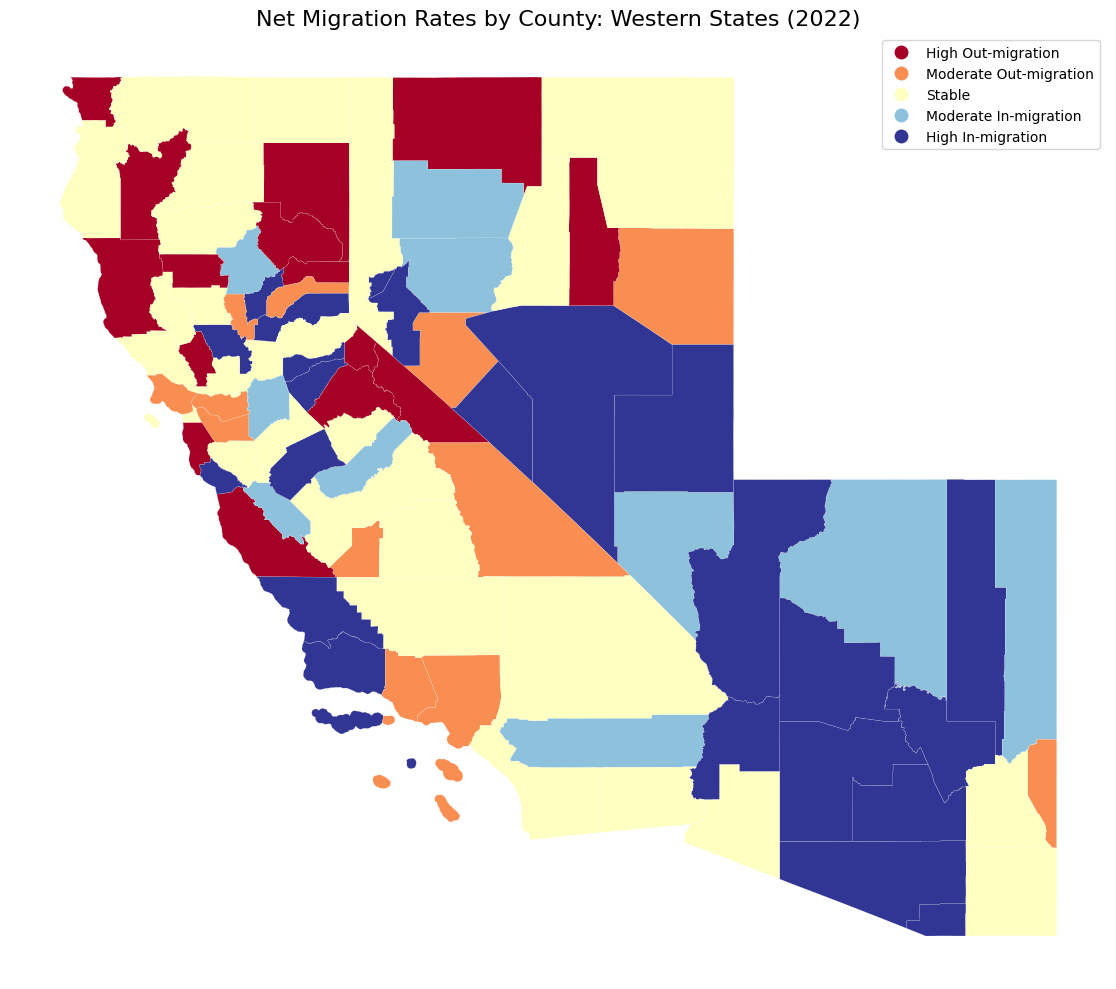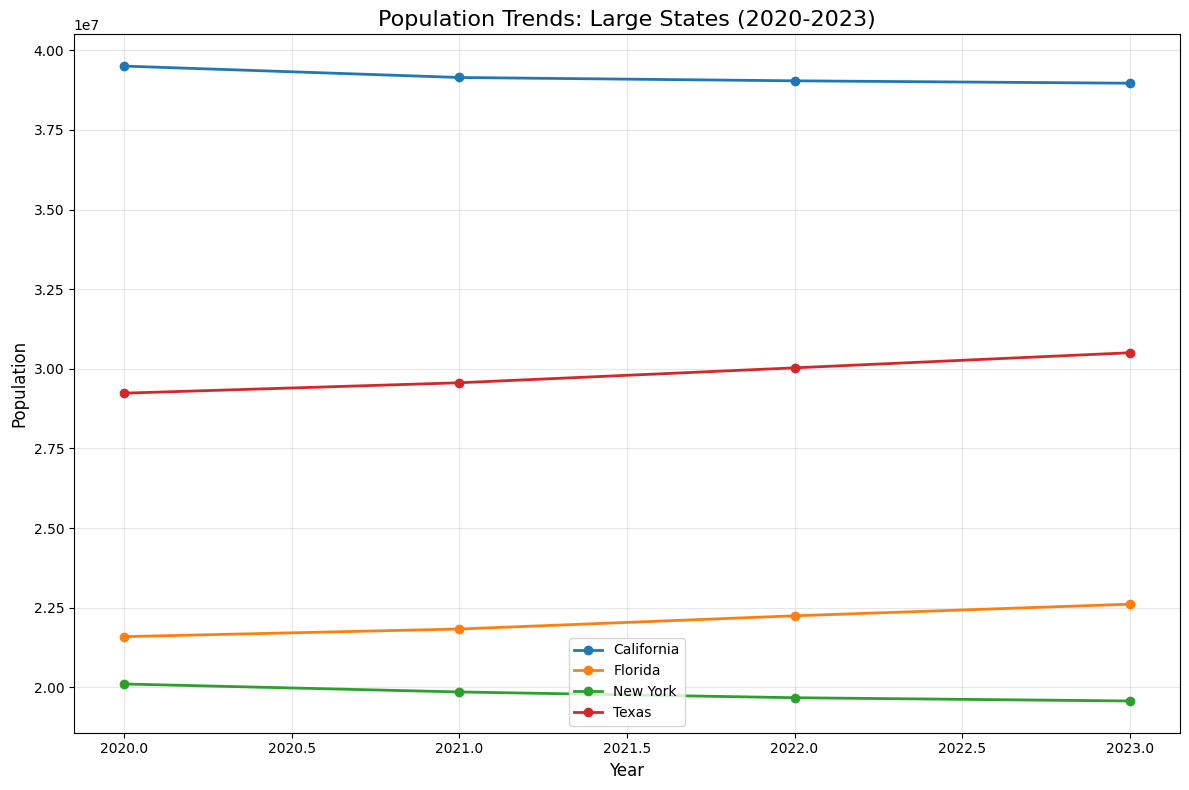Other Census Bureau datasets
Population Estimates Program (PEP)
Purpose: Provides annual population estimates between decennial censuses
Frequency: Updated annually
Geographic Coverage: US, regions, divisions, states, counties, metro areas, places
Time Range: 2010-present (function supports 2015+)
Specific Datasets Within PEP
Population Totals (product=
"population") - Basic population counts by geography - Annual estimates for intercensal yearsComponents of Change (product=
"components") - Births, deaths, migration flows - Natural change calculations - Domestic and international migrationPopulation Characteristics (product=
"characteristics") - Demographics by Age, Sex, Race, Hispanic Origin (ASRH) - Population breakdowns by key demographic categories
Key Parameters
product: “population”, “components”, “characteristics”variables: “POP”, “BIRTHS”, “DEATHS”, migration variables, ratesbreakdown: [“SEX”, “RACE”, “ORIGIN”, “AGEGROUP”] for demographicsvintage: Dataset version (e.g., 2024 for most recent)year: Specific data year (defaults to vintage)time_series: Get multi-year datageometry: Add geographic boundariesoutput: “tidy” (default) or “wide” format
Data Sources
2020+: CSV files from Census Bureau FTP servers
2015-2019: Census API (requires API key)
Automatic handling: No user intervention needed
Geographic Support
All major Census geographies: US, regions, divisions, states, counties, CBSAs, CSAs, places
Mapping Migration Estimates
Let’s create a map of net migration rates:
Census API Key
To use pytidycensus, you need a free API key from the US Census Bureau. Get one at: https://api.census.gov/data/key_signup.html
import pytidycensus as tc
import pandas as pd
import matplotlib.pyplot as plt
tc.set_census_api_key("YOUR API KEY GOES HERE")
Ignore the next cell. It is just to show how users can load their credentials using the new utility function.
import os
# Try to get API key from environment
api_key = os.environ.get("CENSUS_API_KEY")
try:
tc.set_census_api_key(api_key)
print("Using Census API key from environment")
except Exception:
print("Using example API key for documentation")
tc.set_census_api_key("EXAMPLE_API_KEY_FOR_DOCS")
Census API key has been set for this session.
Using Census API key from environment
Product Types and Variables
The get_estimates() function supports three main products:
population (default) - Basic population totals
components - Components of population change
characteristics - Population by demographics
Available Variables
Common variables include:
POP: Total population
BIRTHS: Births
DEATHS: Deaths
DOMESTICMIG: Domestic migration
INTERNATIONALMIG: International migration
NETMIG: Net migration
NATURALCHG: Natural change (births - deaths)
RNETMIG: Net migration rate
#Get county data with geometry for mapping
counties_geo = tc.get_estimates(
geography="county",
variables="RNETMIG", # Net migration rate
year=2022,
geometry=True, # Include geometry for mapping
state=["CA", "NV", "AZ"], # Western states
)
print("County data with geometry:", counties_geo.shape)
print("Data types:", type(counties_geo))
counties_geo.head(3)
Getting data from the 2024 Population Estimates Program (vintage 2024)
/home/mmann1123/Documents/github/pytidycensus/pytidycensus/estimates.py:728: UserWarning: Using vintage 2024 data for year 2022. Consider setting vintage=2022 if available.
warnings.warn(
Warning: Multiple states specified, will filter after download
Loading county boundaries...
County data with geometry: (90, 8)
Data types: <class 'geopandas.geodataframe.GeoDataFrame'>
| GEOID | NAME_x | geometry | STATEFP | COUNTYFP | NAMELSAD | NAME_y | RNETMIG2022 | |
|---|---|---|---|---|---|---|---|---|
| 0 | 06091 | Sierra | POLYGON ((-120.55587 39.50874, -120.55614 39.5... | 06 | 091 | Sierra County | Sierra County, California | -19.960080 |
| 1 | 32001 | Churchill | POLYGON ((-119.22613 39.90038, -119.2261 39.90... | 32 | 001 | Churchill County | Churchill County, Nevada | 9.048192 |
| 2 | 32013 | Humboldt | POLYGON ((-119.33142 41.0391, -119.3314 41.041... | 32 | 013 | Humboldt County | Humboldt County, Nevada | -20.804677 |
Mapping with Geometry
Because we set geometry=True, the returned GeoDataFrame includes geometry data for mapping.
#Create a map of net migration rates
fig, ax = plt.subplots(figsize=(15, 10))
# Create migration categories for better visualization
counties_geo["migration_category"] = pd.cut(
counties_geo["RNETMIG2022"],
bins=[-float("inf"), -10, -5, 5, 10, float("inf")],
labels=[
"High Out-migration",
"Moderate Out-migration",
"Stable",
"Moderate In-migration",
"High In-migration",
],
)
# Plot the map
counties_geo.plot(
column="migration_category",
legend=True,
ax=ax,
cmap="RdYlBu",
edgecolor="white",
linewidth=0.1,
)
ax.set_title("Net Migration Rates by County: Western States (2022)", fontsize=16)
ax.set_axis_off()
plt.tight_layout()
plt.show()

Geographic Levels
Population estimates support multiple geographic levels beyond states:
# Metropolitan areas (CBSAs)
metros = tc.get_estimates(
geography="cbsa",
variables="POP",
year=2022
)
print(f"Metro areas: {metros.shape[0]} CBSAs")
print("Largest metropolitan areas:")
metros_largest = metros.nlargest(10, 'POPESTIMATE2022')
print(metros_largest[['NAME', 'POPESTIMATE2022']])
/home/mmann1123/Documents/github/pytidycensus/pytidycensus/estimates.py:728: UserWarning: Using vintage 2024 data for year 2022. Consider setting vintage=2022 if available.
warnings.warn(
Getting data from the 2024 Population Estimates Program (vintage 2024)
Metro areas: 925 CBSAs
Largest metropolitan areas:
NAME POPESTIMATE2022
1030 New York-Newark-Jersey City, NY-NJ 19619844
860 Los Angeles-Long Beach-Anaheim, CA 12906936
293 Chicago-Naperville-Elgin, IL-IN 9310017
394 Dallas-Fort Worth-Arlington, TX 7973603
640 Houston-Pasadena-The Woodlands, TX 7403068
1521 Washington-Arlington-Alexandria, DC-VA-MD-WV 6289810
65 Atlanta-Sandy Springs-Roswell, GA 6253070
1126 Philadelphia-Camden-Wilmington, PA-NJ-DE-MD 6252024
929 Miami-Fort Lauderdale-West Palm Beach, FL 6211194
1142 Phoenix-Mesa-Chandler, AZ 5029933
# County-level data for Texas
tx_counties = tc.get_estimates(
geography="county",
variables="POP",
state="TX",
year=2022
)
print(f"Texas counties: {tx_counties.shape[0]} counties")
print("Largest Texas counties by population:")
tx_largest = tx_counties.nlargest(10, 'POPESTIMATE2022')
print(tx_largest[['NAME', 'POPESTIMATE2022']])
Getting data from the 2024 Population Estimates Program (vintage 2024)
/home/mmann1123/Documents/github/pytidycensus/pytidycensus/estimates.py:728: UserWarning: Using vintage 2024 data for year 2022. Consider setting vintage=2022 if available.
warnings.warn(
Texas counties: 254 counties
Largest Texas counties by population:
NAME POPESTIMATE2022
2669 Harris County, Texas 4806747
2625 Dallas County, Texas 2613712
2788 Tarrant County, Texas 2161670
2583 Bexar County, Texas 2063840
2795 Travis County, Texas 1332544
2611 Collin County, Texas 1163724
2629 Denton County, Texas 980355
2647 Fort Bend County, Texas 893319
2676 Hidalgo County, Texas 889799
2639 El Paso County, Texas 868890
# Get time series data for select states
time_series_states = tc.get_estimates(
geography="state",
variables="POP",
time_series=True,
vintage=2023, # Use 2023 vintage for data through 2023
state=["CA", "TX", "FL", "NY"], #Focus on large states
)
print("Time series data shape:", time_series_states.shape)
print("Years available:", sorted(time_series_states["year"].unique()))
time_series_states.head(10)
Getting data from the 2023 Population Estimates Program (vintage 2023)
Time series data shape: (16, 5)
Years available: [2020, 2021, 2022, 2023]
| GEOID | NAME | variable | year | estimate | |
|---|---|---|---|---|---|
| 0 | 06 | California | POPESTIMATE | 2020 | 39503200 |
| 1 | 12 | Florida | POPESTIMATE | 2020 | 21591299 |
| 2 | 36 | New York | POPESTIMATE | 2020 | 20104710 |
| 3 | 48 | Texas | POPESTIMATE | 2020 | 29234361 |
| 4 | 06 | California | POPESTIMATE | 2021 | 39145060 |
| 5 | 12 | Florida | POPESTIMATE | 2021 | 21830708 |
| 6 | 36 | New York | POPESTIMATE | 2021 | 19854526 |
| 7 | 48 | Texas | POPESTIMATE | 2021 | 29561286 |
| 8 | 06 | California | POPESTIMATE | 2022 | 39040616 |
| 9 | 12 | Florida | POPESTIMATE | 2022 | 22245521 |
# Plot population trends
plt.figure(figsize=(12, 8))
for state in time_series_states['NAME'].unique():
state_data = time_series_states[time_series_states['NAME'] == state]
plt.plot(state_data['year'], state_data['estimate'],
marker='o', linewidth=2, label=state)
plt.title('Population Trends: Large States (2020-2023)', fontsize=16)
plt.xlabel('Year', fontsize=12)
plt.ylabel('Population', fontsize=12)
plt.legend()
plt.grid(True, alpha=0.3)
plt.tight_layout()
plt.show()

Basic Population Estimates
Let’s start with basic population estimates by state:
# Get population estimates for US states
us_pop_estimates = tc.get_estimates(
geography="state",
variables="POP",
year=2022
)
print(f"Shape: {us_pop_estimates.shape}")
print("Data format:", us_pop_estimates.columns.tolist())
us_pop_estimates.head()
Getting data from the 2024 Population Estimates Program (vintage 2024)
Shape: (52, 3)
Data format: ['GEOID', 'NAME', 'POPESTIMATE2022']
/home/mmann1123/Documents/github/pytidycensus/pytidycensus/estimates.py:728: UserWarning: Using vintage 2024 data for year 2022. Consider setting vintage=2022 if available.
warnings.warn(
| GEOID | NAME | POPESTIMATE2022 | |
|---|---|---|---|
| 14 | 01 | Alabama | 5076181 |
| 15 | 02 | Alaska | 734442 |
| 16 | 04 | Arizona | 7377566 |
| 17 | 05 | Arkansas | 3047704 |
| 18 | 06 | California | 39142414 |
# Get components of population change
us_components = tc.get_estimates(
geography="state",
product="components", # Specify components product
variables=["BIRTHS", "DEATHS", "DOMESTICMIG", "INTERNATIONALMIG"],
year=2022,
output="tidy" # Tidy format for easier analysis
)
print("Components data shape:", us_components.shape)
print("Variables available:", us_components['variable'].unique())
us_components.head(10)
/home/mmann1123/Documents/github/pytidycensus/pytidycensus/estimates.py:728: UserWarning: Using vintage 2024 data for year 2022. Consider setting vintage=2022 if available.
warnings.warn(
Getting data from the 2024 Population Estimates Program (vintage 2024)
Components data shape: (208, 4)
Variables available: ['BIRTHS2022' 'DEATHS2022' 'DOMESTICMIG2022' 'INTERNATIONALMIG2022']
| GEOID | NAME | variable | estimate | |
|---|---|---|---|---|
| 0 | 01 | Alabama | BIRTHS2022 | 58103 |
| 1 | 02 | Alaska | BIRTHS2022 | 9359 |
| 2 | 04 | Arizona | BIRTHS2022 | 79173 |
| 3 | 05 | Arkansas | BIRTHS2022 | 36115 |
| 4 | 06 | California | BIRTHS2022 | 424071 |
| 5 | 08 | Colorado | BIRTHS2022 | 62659 |
| 6 | 09 | Connecticut | BIRTHS2022 | 35637 |
| 7 | 10 | Delaware | BIRTHS2022 | 10849 |
| 8 | 11 | District of Columbia | BIRTHS2022 | 8502 |
| 9 | 12 | Florida | BIRTHS2022 | 221941 |
Demographic Breakdowns
One of the most powerful features is demographic breakdowns using the breakdown parameter. This accesses the Age, Sex, Race, Hispanic Origin (ASRH) datasets:
# Get population by sex for all states
pop_by_sex = tc.get_estimates(
geography="state",
variables="POP",
breakdown=["SEX"],
breakdown_labels=True, # Include human-readable labels
year=2022
)
print("Population by sex data:")
print(pop_by_sex.head(10))
# Check the breakdown categories
if 'SEX_label' in pop_by_sex.columns:
print("\nSex categories:", pop_by_sex['SEX_label'].unique())
Getting data from the 2024 Population Estimates Program (vintage 2024)
/home/mmann1123/Documents/github/pytidycensus/pytidycensus/estimates.py:728: UserWarning: Using vintage 2024 data for year 2022. Consider setting vintage=2022 if available.
warnings.warn(
Processing characteristics data with breakdown: ['SEX']
Population by sex data:
STATE NAME SEX ORIGIN RACE AGE GEOID estimate year variable \
0 1 Alabama 1 0 0 0 01 29531 2022 POP
1 1 Alabama 2 0 0 0 01 28195 2022 POP
2 2 Alaska 1 0 0 0 02 4808 2022 POP
3 2 Alaska 2 0 0 0 02 4504 2022 POP
4 4 Arizona 1 0 0 0 04 40228 2022 POP
5 4 Arizona 2 0 0 0 04 38496 2022 POP
6 5 Arkansas 1 0 0 0 05 18258 2022 POP
7 5 Arkansas 2 0 0 0 05 17590 2022 POP
8 6 California 1 0 0 0 06 217463 2022 POP
9 6 California 2 0 0 0 06 208334 2022 POP
SEX_label
0 Male
1 Female
2 Male
3 Female
4 Male
5 Female
6 Male
7 Female
8 Male
9 Female
Sex categories: ['Male' 'Female']